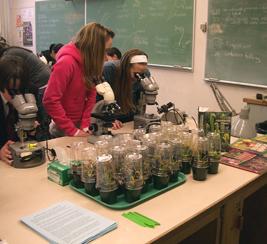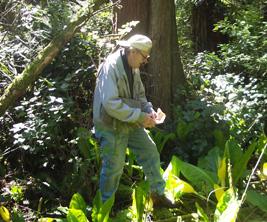There are many inquiring minds outside the gates of the university. One of our responsibilities is to make science more accessible to the public. I work with a number of groups ranging in age and backgrounds. It has been an education for me as well as them. Many activities I do on a regular basis while others are ad-hoc. School groups and other interest groups such as the Native Plant Society and the Mycological Society are eager to go on fieldtrips as well as explore the microscopic world of organisms. Developing these programs is not only very rewarding personally, but also an excellent creative outlet.
 A. Scientist in Residence Program – SRP (Vancouver School Board)
A. Scientist in Residence Program – SRP (Vancouver School Board)
I have been involved with the SRP since 2007. There are between 7 and 10 scientists invited to participate each year. Each scientist is matched with two teachers in an elementary school in the Vancouver School District. The scientist and teachers collaborate to develop at least 6 science lessons over the year, that include experimentation and the scientific method. The IRP (Ministry of Education) includes the prescribed learning outcomes (PLO) by year level which help guide the topics and level of detail. My sessions include classroom, lab, and fieldtrip activities.
The lesson plans are published on the Scientist in Residence website.
Links to my SRP lessons
Schools I have partnered with:
Charles Dickens Elementary School – Grades (3), 4, and 5 (2007/2008)
False Creek Elementary School – Grade 2 (2008/2009)
Sir John Franklin Elementary – Grades 2/3 and 6 (2009/2010)
Carleton Elementary – Grade 4 (2010/2011)
Mount Pleasant Elementary – Grades 5/6 and 6/7 (2011/2012)
University Hill Elementary – Grades 1/2 (2012/2013)
I participated in “In Session:The Scientist in Residence” a video about the program.
 B. Science 101 (2000, 2001, 2002, 2005, 2007, 2009, 2010, 2011, 2012)
B. Science 101 (2000, 2001, 2002, 2005, 2007, 2009, 2010, 2011, 2012)
Underprivileged adults from the Vancouver Eastside apply for this program. It is summer long and volunteers from different departments in the Faculty Science volunteer their time to put on activities for the students. I generally do an evening lecture (this year was Plant Sex) and another day of fieldtrip and lab activities. I have given a speech at two of the graduation ceremonies (e.g. presentation at 2011 grad). Science 101 is one of the most rewarding outreach activities I do. It is so satisfying watching these students discover the intricacies of nature around them.
 C. Aboriginal Summer Science (science with First Nations high school students)
C. Aboriginal Summer Science (science with First Nations high school students)
Faculty of Science
(2002, 2003, 2005, 2006, 2008, 2009, 2010)
First Nations students make up a small proportion of students on-campus. This program helps to make university a less intimidating option. The youth interact with university students and faculty members while learning about different aspects of science. I include either fieldtrips or lab activities in my program.
 D. CEDAR Summer Camp (science with First Nations middle school students)
D. CEDAR Summer Camp (science with First Nations middle school students)
(2008, 2009, 2010, 2012)
Faculties of Science and Land and Food Systems
This educational outreach program brings youth to UBC to explore in the field and lab. I have done plant-related lab programs. Examples of activities include “Carnivores to Conifers” and “Plants that Heal, Plants that Harm”.
 E. Salmonberry Days (Dunbar Residence Association)
E. Salmonberry Days (Dunbar Residence Association)
Botanical identification activity at the Salmonberry Festival (one day, May 1998, 1999, 2000, 2001, 2002, 2003, 2004, 2005, 2006, 2007, 2008, 2009, 2010, 2011, 2013)
The month of May, known as Salmonberry Days, is full of activities in the Dunbar community. The Salmonberry Festival is held on the last Sunday of the month and every year Lacey Samuels and I present a quiz table with three sets of quizzes (matching game) that test knowledge of trees, mosses, dinosaur plants, insectivorous plants, seaweed, etc. Example of organization list.
 Fieldtrips to Pacific Spirit Park for Salmonberry Days (2001, 2002, 2003, 2004, 2005, 2006, 2007, 2008, 2009, 2010, 2011, 2013)
Fieldtrips to Pacific Spirit Park for Salmonberry Days (2001, 2002, 2003, 2004, 2005, 2006, 2007, 2008, 2009, 2010, 2011, 2013)
During May, as part of Salmonberry Days, I lead a nature walk to Pacific Spirit Park/Camosun Bog to examine the diversity of local bryophytes.
(Appendix B-IV, pgs A-58, A-60).
 The Biology 321 class collaborates with the Camosun Bog Restoration Group and Stanley Park. The Bog restoration projects have provided opportunities for students to contribute to community ecosystem restoration work.
The Biology 321 class collaborates with the Camosun Bog Restoration Group and Stanley Park. The Bog restoration projects have provided opportunities for students to contribute to community ecosystem restoration work.
 F. Undergraduate Volunteers:
F. Undergraduate Volunteers:
I would not be able to provide these programs without the assistance of undergraduate volunteers. I involve them in both the planning stages and teaching. Their participation has been very rewarding as I get to see them apply their botanical/biological knowledge. They are also very pleased with themselves and many of them are eager to take part in other outreach activities. They are enthusiastic and serve as excellent role models for youth.
Example: student guide to forest fieldtrip (part of Contrasting Landscapes)
G. Other Outreach Activities:
- Tour of “Learning Biology at UBC” for students of the Tokyo Gakugei International Secondary School (Nov, 2012)
- Brainwave – Summer Camp for youth: Camosun Bog and Forest Walks (summer, 2012)
- Elementary Science Interest Group – Vancouver School Board (2010 – present)
- Shad Valley (Canadian summer enrichment program for high school youth) – A Day of Fibre: lecture, fieldtrip, and Lab) (Aug. 2009)
- Slideshow: “A Traveling Botanist” – Charles Dickens Elementary School (April, 2009)
- Fieldtrip to Cates Park (Intertidal activities) – Charles Dickens Elementary School, May 2008
- Fieldtrip to UBC Farm (Agriculture/Forest) – June 2008
- Stanley Park fieldtrip with students from Columbia College, July 2007, 2008, 2009, 2010
- VanDusen Garden Lecture: “Messing Mossing up the Garden” 2010
- “Being Green”, December, 2003 and February, 2005, 2008 – Evening Program with Girl Guides
- Grade 6 class from Ecole Jules Quesnel – Microscopy Day – examining organisms from different ecosystems (2009).
- Young Naturalists (Youth program through the Vancouver Natural History Society) – Lab program on different topics: The World of Carnivorous Plants, (2003), Slime from the Sea (Nov. 2005), Plants that Stink (2007), Plants’n’Bugs (2008), Pollination Biology (2009), Plants that Kill (2010), The Little Things in Life (2012)
- “Slime from the Sea” – for homeschooled elementary-aged children (Nov. 2005),
- “Botanical Latin” – Adult Education program for VanDusen Garden, Sept. 2005
- A Microscopic Look at Plants – an in-lab workshop with members of the Southcoast Study Group of the Native Plant society of B. C. 2005
- “Being a Plant” – School visit to Queen Mary Elementary (MAC Class), May 2004
- “Basics about Bryophytes” – co-presenter Wilf Schofield – Botanical Garden Seminar Series, May 2004
- “Elves of the Woods” – Presentation for Friends of the Garden (UBC Botanical Garden FOGS), May 2004
- Volunteer for UBC Farm forest trail upgrade project (2003) – developed Agroforestry Trail
- Two–day workshop co-taught Dr. Schofield for the Native Plant society of B.C. on Bryophytes (Oct, 2004)
- Volunteer at VanDusen Plant Sale (April, 2002, 2003, 2004)
- “Lunch ‘n’ Learn (for MDS Nordion staff members from TRIUMF) – Nature walk in Pacific Spirit Park (one lunch hour per year (1999, 2000, 2001, 2002)
- Prince of Wales Mentorship Program (5 grade ten student, 1 grade 11), Sept. 2000 to Jan. 2004
- “Ferns to Know and Grow” (Workshop on fern biology and propagation – given at the Native Plant Sale, UBC Botanical Garden, 2002)
- Fieldtrips for various school groups – kindergarten and grade 5 (e.g. Balcarra Bay trails, Delta Nature Reserve)
- Burns Bog Fieldtrip – Native Plant Society (June, 2002)
- “Flowers to Fruit” – workshop for grade one students at Lord Roberts Annex (school visit)
- Bog Day Coordinator for Richmond Nature Park (July 2002)
- Slide show presentation at Bog Day: “Living in a Bog” (July, 2002, 2003, 2004)
- Slideshow “Flora of the Queen Charlotte Islands” for the Native Plant Society (March, 2002)
- “Slog in the Bog” Weekend Workshop for the Native Plant Society (August 2001)
